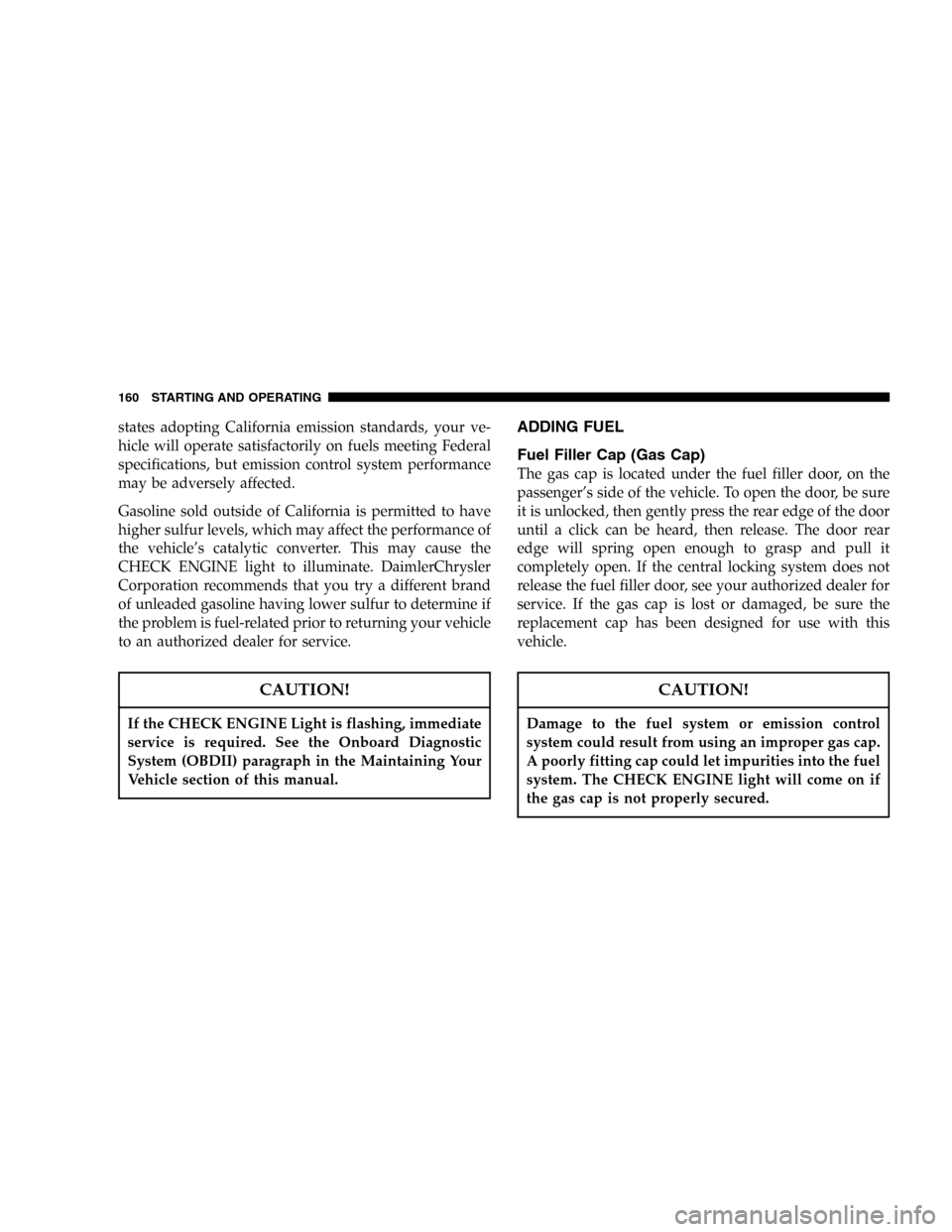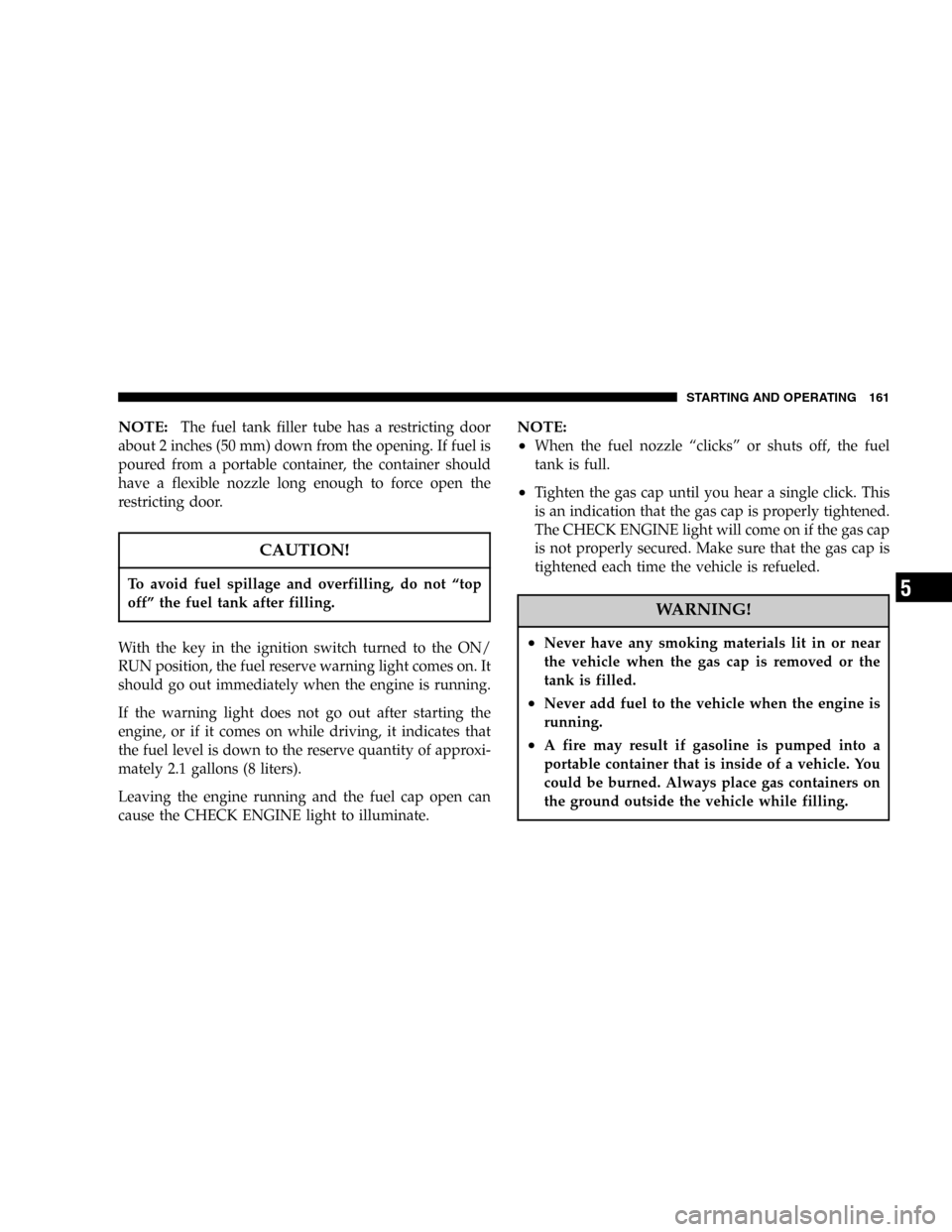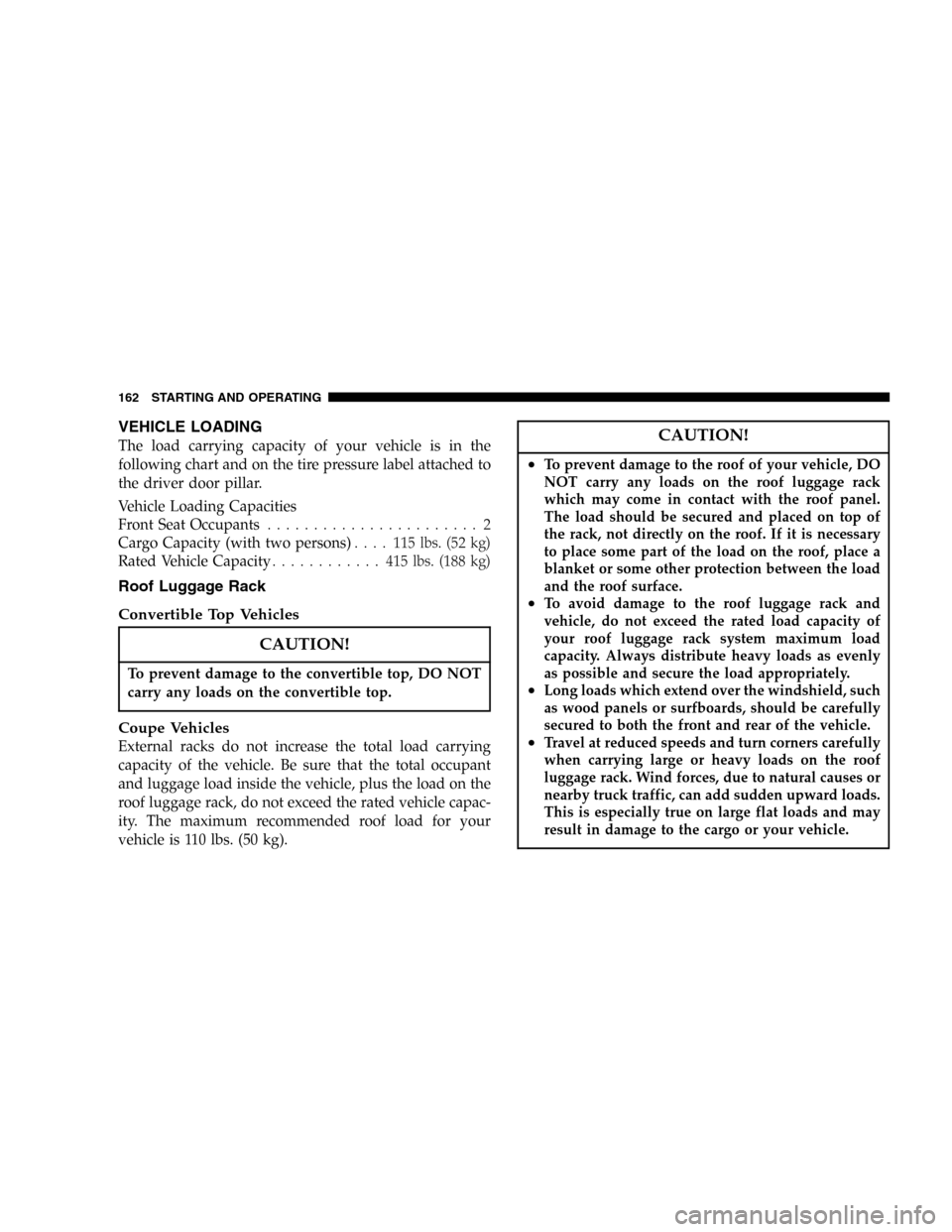ECU CHRYSLER CROSSFIRE SRT 2005 1.G Owner's Manual
[x] Cancel search | Manufacturer: CHRYSLER, Model Year: 2005, Model line: CROSSFIRE SRT, Model: CHRYSLER CROSSFIRE SRT 2005 1.GPages: 280, PDF Size: 14.34 MB
Page 133 of 280

Maneuvering
To maneuver in tight areas, control the vehicle speed by
gradually releasing the brakes. Accelerate gently and
never abruptly step on the accelerator.
To rock a vehicle out of soft ground (mud or snow),
alternately shift from forward to reverse, while applying
only slight acceleration. Rocking a vehicle free in this
manner may cause the ABS or traction system malfunc-
tion indicator light to come on. Turn off the engine and
restart the engine to clear the malfunction indication.
Park Position
The PARK position is to be used when parking the
vehicle. Engage only with the vehicle stopped. The PARK
position is not intended to serve as a brake when the
vehicle is parked. Rather, the driver should always use
the parking brake in addition to placing the selector lever
in PARK to secure the vehicle.
NOTE:The key can be removed from the ignition
switch only with the selector lever in the PARK position.
With the key removed, the selector lever is locked in the
PARK position.
With a malfunction in the vehicle’s electrical system, the
selector lever could remain locked in the PARK position.
To unlock the selector lever manually, insert the end of
the multipurpose tool from the glove box (or ball point
pen) into the covered opening below the position“D”of
the shift pattern. While pushing the tool down, move the
selector lever out of the PARK position. After removal of
STARTING AND OPERATING 133
5
Page 160 of 280

states adopting California emission standards, your ve-
hicle will operate satisfactorily on fuels meeting Federal
specifications, but emission control system performance
may be adversely affected.
Gasoline sold outside of California is permitted to have
higher sulfur levels, which may affect the performance of
the vehicle’s catalytic converter. This may cause the
CHECK ENGINE light to illuminate. DaimlerChrysler
Corporation recommends that you try a different brand
of unleaded gasoline having lower sulfur to determine if
the problem is fuel-related prior to returning your vehicle
to an authorized dealer for service.
CAUTION!
If the CHECK ENGINE Light is flashing, immediate
service is required. See the Onboard Diagnostic
System (OBDII) paragraph in the Maintaining Your
Vehicle section of this manual.
ADDING FUEL
Fuel Filler Cap (Gas Cap)
The gas cap is located under the fuel filler door, on the
passenger’s side of the vehicle. To open the door, be sure
it is unlocked, then gently press the rear edge of the door
until a click can be heard, then release. The door rear
edge will spring open enough to grasp and pull it
completely open. If the central locking system does not
release the fuel filler door, see your authorized dealer for
service. If the gas cap is lost or damaged, be sure the
replacement cap has been designed for use with this
vehicle.
CAUTION!
Damage to the fuel system or emission control
system could result from using an improper gas cap.
A poorly fitting cap could let impurities into the fuel
system. The CHECK ENGINE light will come on if
the gas cap is not properly secured.
160 STARTING AND OPERATING
Page 161 of 280

NOTE:The fuel tank filler tube has a restricting door
about 2 inches (50 mm) down from the opening. If fuel is
poured from a portable container, the container should
have a flexible nozzle long enough to force open the
restricting door.
CAUTION!
To avoid fuel spillage and overfilling, do not“top
off”the fuel tank after filling.
With the key in the ignition switch turned to the ON/
RUN position, the fuel reserve warning light comes on. It
should go out immediately when the engine is running.
If the warning light does not go out after starting the
engine, or if it comes on while driving, it indicates that
the fuel level is down to the reserve quantity of approxi-
mately 2.1 gallons (8 liters).
Leaving the engine running and the fuel cap open can
cause the CHECK ENGINE light to illuminate.
NOTE:
•
When the fuel nozzle“clicks”or shuts off, the fuel
tank is full.
•Tighten the gas cap until you hear a single click. This
is an indication that the gas cap is properly tightened.
The CHECK ENGINE light will come on if the gas cap
is not properly secured. Make sure that the gas cap is
tightened each time the vehicle is refueled.
WARNING!
•Never have any smoking materials lit in or near
the vehicle when the gas cap is removed or the
tank is filled.
•Never add fuel to the vehicle when the engine is
running.
•A fire may result if gasoline is pumped into a
portable container that is inside of a vehicle. You
could be burned. Always place gas containers on
the ground outside the vehicle while filling.
STARTING AND OPERATING 161
5
Page 162 of 280

VEHICLE LOADING
The load carrying capacity of your vehicle is in the
following chart and on the tire pressure label attached to
the driver door pillar.
Vehicle Loading Capacities
Front Seat Occupants....................... 2
Cargo Capacity (with two persons).... 115lbs. (52 kg)
Rated Vehicle Capacity............ 415lbs. (188 kg)
Roof Luggage Rack
Convertible Top Vehicles
CAUTION!
To prevent damage to the convertible top, DO NOT
carry any loads on the convertible top.
Coupe Vehicles
External racks do not increase the total load carrying
capacity of the vehicle. Be sure that the total occupant
and luggage load inside the vehicle, plus the load on the
roof luggage rack, do not exceed the rated vehicle capac-
ity. The maximum recommended roof load for your
vehicle is 110 lbs. (50 kg).
CAUTION!
•To prevent damage to the roof of your vehicle, DO
NOT carry any loads on the roof luggage rack
which may come in contact with the roof panel.
The load should be secured and placed on top of
the rack, not directly on the roof. If it is necessary
to place some part of the load on the roof, place a
blanket or some other protection between the load
and the roof surface.
•To avoid damage to the roof luggage rack and
vehicle, do not exceed the rated load capacity of
your roof luggage rack system maximum load
capacity. Always distribute heavy loads as evenly
as possible and secure the load appropriately.
•Long loads which extend over the windshield, such
as wood panels or surfboards, should be carefully
secured to both the front and rear of the vehicle.
•Travel at reduced speeds and turn corners carefully
when carrying large or heavy loads on the roof
luggage rack. Wind forces, due to natural causes or
nearby truck traffic, can add sudden upward loads.
This is especially true on large flat loads and may
result in damage to the cargo or your vehicle.
162 STARTING AND OPERATING
Page 163 of 280

WARNING!
Cargo must be securely tied before driving your
vehicle. Improperly secured loads can fly off the
vehicle, particularly at high speeds, resulting in
personal injury or property damage. Follow the roof
luggage rack“Cautions”when carrying cargo on
your roof rack.
TRAILER TOWING
Trailer towing with your Crossfire is not recommended.
STARTING AND OPERATING 163
5
Page 173 of 280

NOTE:Do not raise the vehicle until you are sure the
jack is securely engaged, as shown.3. Holding the jack, insert the cradle under the lifting
points. Crank the handle clockwise until the jack base
meets the ground. Place the jack on firm ground. Position
the jack so that it is always level, even if the vehicle is
parked on an incline. Raise the vehicle only until the tire
just clears the surface. Minimum tire lift provides maxi-
mum stability.
4. Replace the tire.
5. Lower the vehicle by cranking the handle counter-
clockwise, then remove the jack assembly.
WHAT TO DO IN EMERGENCIES 173
6
Page 182 of 280

the vehicle is locked again with a key or the remote
control, at which time it is automatically reactivated.
CONVERTIBLE TOP EMERGENCY OPERATION
If the convertible top cannot be closed using the convert-
ible top switch, check the following:
•Is the decklid closed properly?
•Is there sufficient battery voltage? Start the engine if
necessary.
•Is the rear cargo compartment divider secured in the
vertical position?
If the power convertible top operation does not function
properly, you can close the convertible top manually.
NOTE:The multifunction tool from the glovebox is
required for this job.
CAUTION!
Manually closing the convertible top is a compli-
cated and technically demanding procedure. Closing
the convertible top manually should be performed
with great care by two people. Close the convertible
top manually in emergency cases only. Otherwise,
visit an authorized DaimlerChrysler Dealer.
182 WHAT TO DO IN EMERGENCIES
Page 184 of 280

3. Unlock the storage compartment by placing the tool
on the bolt between the backrest and the tonneau cover.
Turn the wrench in the direction of the arrow to its stop
and remove the tool.
4. Open the tonneau cover and secure it in the upright
position.5. Pull up hard on the upper section of the convertible
top to move it out of its storage compartment.
NOTE:Do not let go of the convertible top as it may fall
back into the convertible top storage compartment.
184 WHAT TO DO IN EMERGENCIES
Page 211 of 280

•If frequent coolant additions are required, or if the
level in the recovery bottle does not drop when the
engine cools, the cooling system should be pressure
tested for leaks.
•Maintain a coolant concentration of a minimum of 50%
ethylene glycol Extended Life Coolant and high qual-
ity water with recommended antifreeze for proper
corrosion protection of your engine cooling system
that contains aluminum components.
•Make sure that the radiator and coolant bottle hoses
are not kinked or obstructed.
•Keep the front of the radiator clean. If your vehicle has
air conditioning, keep the front of the condenser clean,
also.
•Do not change the thermostat for summer or winter
operation. If replacement is ever necessary, install
ONLY the correct type thermostat. Other designs may
result in unsatisfactory coolant performance, poor fuel
economy, and increased emissions.
Hoses And Vacuum/Vapor Harnesses
Inspect surfaces of hoses and nylon tubing for evidence
of heat and mechanical damage. Hard or soft spots,
brittle rubber, cracking, checking, tears, cuts, abrasions,
and excessive swelling indicate deterioration of the rub-
ber.
Pay particular attention to the hoses nearest to high heat
sources such as the exhaust manifold. Inspect hose rout-
ing to be sure hoses do not touch any heat source or
moving component that may cause heat damage or
mechanical wear.
Insure nylon tubing in these areas has not melted or
collapsed. Inspect all hose connections such as clamps
and couplings to make sure they are secure and no leaks
are present. Components should be replaced immedi-
ately if there is any evidence of degradation that could
cause failure.
Brakes
In order to assure brake system performance, all brake
system components should be inspected periodically.
Suggested service intervals can be found in the Mainte-
nance section.
MAINTAINING YOUR VEHICLE 211
7
Page 212 of 280

WARNING!
Riding the brakes can lead to brake failure and
possibly an accident. Driving with your foot resting
or riding on the brake pedal can result in abnormally
high brake temperatures, excessive lining wear, and
possible brake damage. You wouldn’t have your full
braking capacity in an emergency.
Brake and Power Steering System Hoses
When servicing the vehicle for scheduled maintenance,
inspect surface of hoses and nylon tubing for evidence of
heat and mechanical damage. Hard and brittle rubber,
cracking, checking, tears, cuts, abrasions, and excessive
swelling suggest deterioration of the rubber. Particular
attention should be made to examining those hose sur-
faces nearest to high heat sources, such as the exhaust
manifold.
Inspect all hose clamps and couplings to make sure they
are secure and no leaks are present.
Insure nylon tubing in these areas has not melted or
collapsed.
NOTE:Often, fluids such as oil, power steering fluid,
and brake fluid are used during assembly plant opera-
tions to ease the assembly of hoses to couplings. There-
fore, oil wetness at the hose-coupling area is not neces-
sarily an indication of leakage. Actual dripping of hot
fluid when systems are under pressure (during vehicle
operation) should be noted before a hose is replaced
based on leakage.
NOTE:Inspection of brake hoses should be done
whenever the brake system is serviced and at every
engine oil change.
WARNING!
Worn brake hoses can burst and cause brake failure.
You could have an accident. If you see any signs of
cracking, scuffing, or worn spots, have the brake
hoses replaced immediately.
212 MAINTAINING YOUR VEHICLE